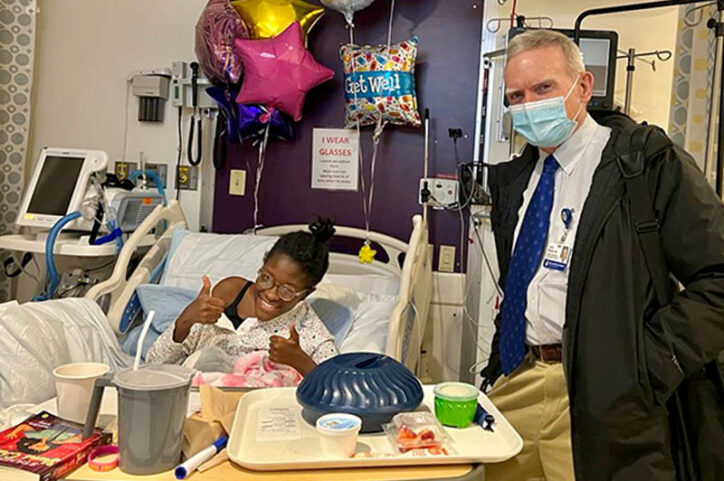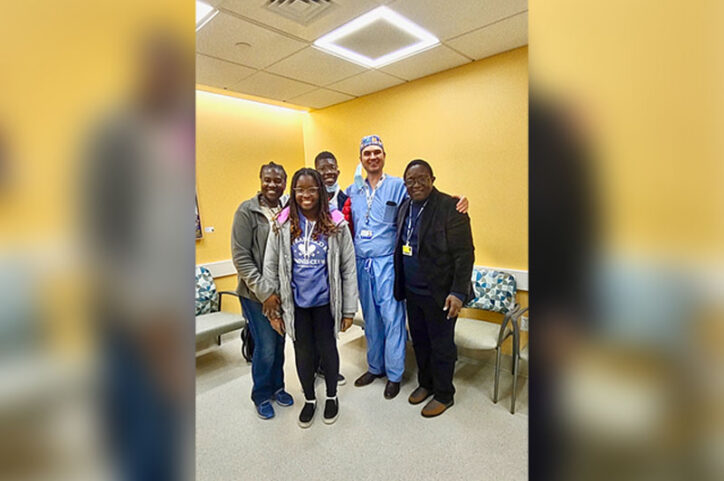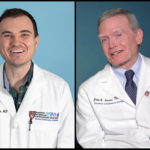Born with congenital scoliosis, Thelma looks to the future

Sixteen-year-old Thelma Alemnji probably enjoys student life more than most high school juniors. After all, up until last year, activities like drama club, debate club, and student government were out of reach.
Born with severe congenital scoliosis and thoracic insufficiency syndrome, Thelma’s childhood and early adolescence were marked by regular hospital visits and frequent surgeries: 19 to be exact. And because her curved spine and missing ribs interfered with her lung function, she was often short of breath and prone to respiratory infections that could last for weeks at a time.
“I was out of school too much to really participate in clubs or other activities,” says Thelma. That changed after her last spine operation in December 2022. Today, extended absences from school no longer hold her back. “I’m glad I get to be more involved now.”

A condition that began before birth
Congenital scoliosis develops during pregnancy, when one or more of the vertebrae in a fetus’ spine don’t form correctly. Children with the condition are born with sideways curves that range from minor to severe. Often, a minor curve doesn’t require treatment other than regular monitoring. In other cases, however, the curve increases as the child grows, making breathing and everyday activities progressively more difficult.
Thelma’s parents, George and Petronilla Alemnji, learned that one of their twins would be born with congenital scoliosis through a level 2 prenatal ultrasound. Dr. John Emans, director of Boston Children’s Spine Division at the time, examined Thelma shortly after her birth and recommended a years-long process of coaxing her spine into a straighter position. But first, he said, Thelma needed time to grow stronger.
A childhood of spine surgeries
When Thelma was 4, Dr. Emans attached VEPTR growing rods — temporary implants that control spinal curvature as a child grows — to her spine. Every six months, Thelma and her parents returned to Boston Children’s so Dr. Emans could lengthen the rods through small incisions in her back. When she outgrew one set of rods (which she did every couple of years), he replaced them with a longer set.

The family continued to return to Boston Children’s throughout Thelma’s childhood, even during the seven years they lived in Barbados, where George, a chemical pathologist in charge of the CDC’s Global HIV Laboratory Program, was posted. Even after moving to the Washington D.C. area, they continued to return to Boston. “Dr. Emans performed all of Thelma’s spine surgeries,” says George.
Perhaps because she understood they would eventually lead to greater independence, Thelma looks back on her surgeries with remarkable calm. “They started when I was so young,” she says, “I was just used to it.” Along the way, Dr. Emans made sure she understood the procedures and the reasons for doing them. “He listened to my questions and showed me X-rays to help me understand what was going on.”
Finally, in December 2022, Thelma underwent spinal fusion surgery. Dr. Emans stabilized her spine with rods that would remain in place and added bone grafts to stimulate her vertebrae to grow into solid bone. The tradeoff was less mobility — Thelma needs to turn her whole torso to look behind her — for more energy and function. Not only is her spine more stable, now that her lungs are no longer compressed, she no longer gets winded easily or sick any time a respiratory infection is going around.
Cervical spine surgery
Her middle and lower spine were stable, but Thelma’s head remained tilted to one side. It was time to straighten her cervical spine (neck) and upper chest.
But first, Thelma needed to gain weight. Despite a diet of protein shakes and nutrition drinks, she remained small and fragile. “They could not perform major surgery unless she had more body mass,” explains George. Finally, in the fall of 2022, Thelma had a G-tube placed in a hospital near the family’s home.
With the G-tube delivering nutrition directly to her stomach, Thelma quickly started putting on weight. By the following November, she had grown sturdy enough to undergo her final and most significant surgery.

The first step in Thelma’s cervical spine surgery began with halo-gravity traction. By then, Dr. Grant Hogue had joined her care team. He and Dr. Emans attached a halo (a lightweight metal ring) to Thelma’s skull. Over the following seven weeks, which Thelma spent in the hospital, a pulley system attached to the halo slowly straightened and lengthened her cervical spine. When her neck had grown long enough, Drs. Emans and Hogue removed the halo and made the length permanent with new rods and a fusion.
Hoping to help others
These days, Thelma sleeps with a BiPAP system that helps her breathe at night. During the day, she has new energy to pursue interests that had long evaded her.
Even as she dives into student life, Thelma still wants to help other patients. In the hospital, she mentored patients and bonded with a girl her age who was also undergoing halo traction. “It’s nice to know you’re not alone,” she reflects.

She and her parents hope that by sharing their story, they can help families in similar circumstances know they too are not alone. In fact, the family plans to raise funds to support children with similar conditions, particularly in developing countries, where such services are rare and, if available, prohibitively expensive.
Throughout the years, physical and moral support from her parents and siblings, John and Lucia, helped Thelma stay positive. “We’ve gone through this together since Thelma was born,” says George. “I encourage parents to collaborate with doctors and nurses so that they can provide their child the support they need.”
“Our faith and hope have kept us going during these years, particularly during the period of Thelma’s last surgery,’’ adds Petronilla.
Looking ahead to her junior year, Thelma says she’s grateful that her many surgeries took place when she was young. “School is getting more serious,” she says. “I’m grateful I don’t have to worry about surgery interfering with my classes or important events.”

Learn more about the Spine Division.
Related Posts :
-

How Josie’s bad day turned into a campaign to help kids with scoliosis
Josephine DeFilippi (Josie) describes the day of her scoliosis diagnosis as the hardest day of her life. Right when she ...
-

A new treatment option for Jeanne’s infantile scoliosis
If it hadn’t been for the pandemic, Jeanne McDaniel’s treatment for infantile scoliosis would have started when she ...
-

Beating the odds and neuromuscular scoliosis: Colin’s story
Colin Newton has a way of surprising people. Born with a rare neuromuscular disorder, he spent the first three months ...
-

Generations of excellence in surgical care: Dr. Emans and Dr. Hogue
Some surgeons follow their patients for years, even decades. This is true of Dr. John Emans, who has treated patients ...





